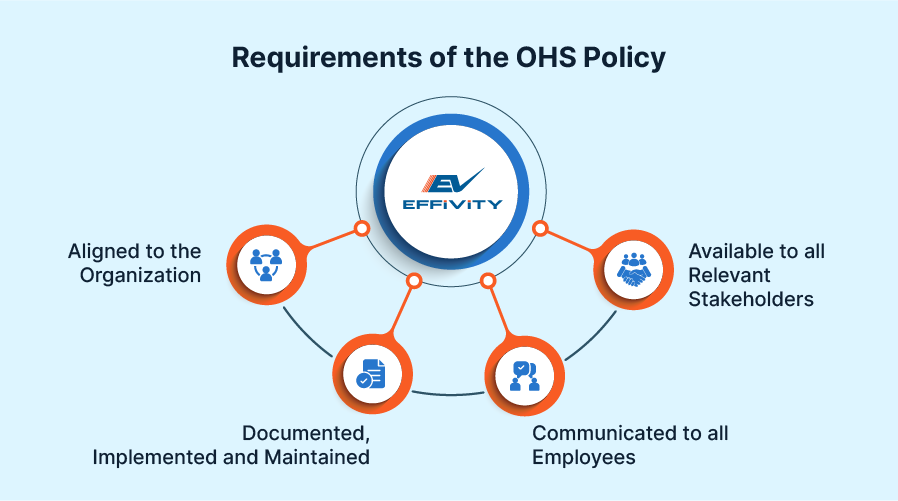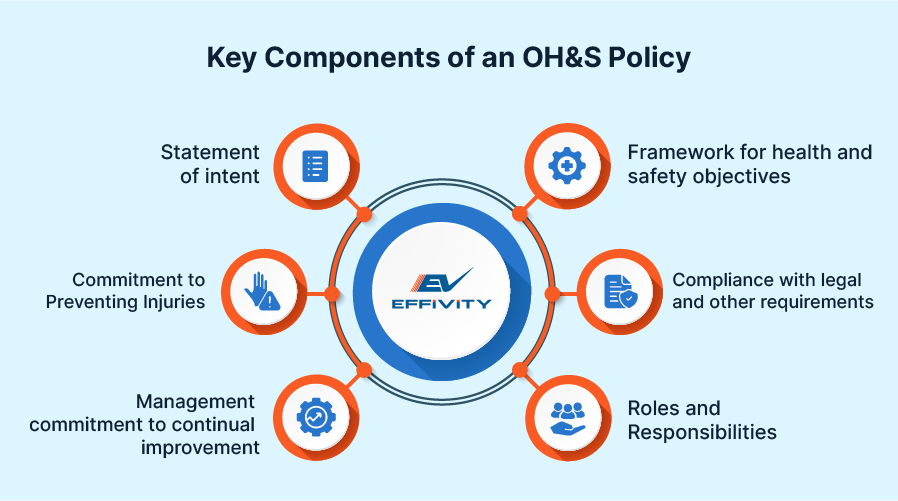When it comes to implementing an occupational health and safety management system software within your workplace under ISO standards, you'll need to meet various documentation requirements. While the OHSAS 18001 standard does not entail extensive document needs, it does require you to create and share a comprehensive OH&S policy.
An Occupational Health and Safety policy is a crucial document defined by the top management, setting the foundation for a safe and healthy working environment. While the actual OH&S Policy for an organization will differ widely depending on the exact nature of the business, some general guidelines can be used to define one for your company.
Let's dive into what an OHS policy is, what the key components are, and how to write one.
What is an OHS Policy?
An OH&S policy is a formal statement outlining an organization's commitment to the health, safety, and well-being of its employees. It underlines the overall direction and intentions of how the organization will handle occupational health and safety concerns.
It also serves as a guideline for implementing and maintaining safety standards, ensuring compliance with legal requirements, and fostering a culture of safety within the workplace. The top management creates this policy, defining the roles and responsibilities of each employee and stating the commitment of the organization to improve their occupational health and safety procedures.
Requirements of the OHS Policy
The organization must meet the following requirements while writing an OH&S policy for its occupational, health, and safety management system-

1. Aligned to the organization
Your OHS policy must be aligned with the organization's goals and objectives. The policy must be appropriate to the nature, operations, and OH&S risk levels of your organization. For instance, if your organization is a manufacturing company, focusing your OHS policy on office hazards and issues will be inappropriate.
Instead, the policy must be aligned with the nature of operations and the risk levels workers might come across during various manufacturing processes.
2. Documented, implemented, and maintained
The OHS policy must be clearly documented to ensure accessibility. Once documented in the written or digital format, it must be implemented effectively by planning and allocating resources to ensure that the commitments made in your policy are met efficiently.
As your organization grows and OHS risks change, the policy must also be updated to reflect these changes and address the hazards proactively.
3. Communicated to all employees
You must share and communicate this policy with all the employees to help them understand the company's OHS objectives and how they can contribute to them. They must understand the intention behind implementing an occupational health and safety management system along with their roles and responsibilities.
4. Available to all relevant stakeholders
The OHS policy is one critical document that also needs to be shared with external stakeholders to demonstrate the company's commitment to occupational health and safety. You can consider publishing the policy on the company's website or sharing it with the interested parties who ask.
This requirement indirectly allows you to use the investment in an OH&S management system as a tool for publicity.
Key Components of an OH&S Policy

1. Statement of intent
The Occupational Health and Safety (OHS) policy should start with a statement of intent that clearly expresses the organization's commitment to maintaining a safe and healthy work environment. It should outline the objectives and goals related to OH&S and affirm the organization's dedication to continuous improvement in safety standards.
2. Commitment to preventing injuries
The policy must include a commitment to prevent ill health and injury within the organization. The policy does not have to mention how you will prevent injuries and ill health, but it should be a necessary detail when sharing with an auditor.
3. Management commitment to continual improvement
A major reason why companies implement a management system is to identify key safety processes and improve management. The OH&S policy should contain a commitment to the continuous improvement of processes that impact occupational health and safety.
Once again, there is no need to describe how this will be done, only that the organization is committed to making it happen.
4. Framework for health and safety objectives
Within this, you need to establish specific, measurable objectives related to OH&S. These objectives should align with the organization's overall mission and goals, providing a clear direction for safety initiatives.
For instance, if your goal of implementing an occupational health and safety management system is to create a safer, more productive work environment for your employees, then the policy must reflect that.
5. Compliance with legal and other requirements
Lastly, the organization needs to commit to complying with legal and other requirements that are applicable to occupational health and safety.
In the framework for objectives, you can describe the OHS goals that apply to your company. Within the compliance section of your policy, you will define plans to reach the objectives relating to the improvement of the company's occupational health and safety.
Both your improvement plans and overall objectives must support the OH&S policy. Be careful not to add anything to the policy that you won't be able to act on when you implement plans to improve the system.
6. Roles and Responsibilities
The policy can also define the roles and responsibilities of all employees, from top management to front-line workers. This section should specify who is accountable for implementing and monitoring the OH&S policy and highlight the importance of everyone's participation in maintaining safety standards and addressing risks.
How to Write an OHS Policy?
Although there are a number of requirements regarding the policy, that doesn't mean you have to write an extensive policy describing each requirement in detail.
The OHSAS 18001 standard does not require you to describe how you'll fulfil the requirements; you only state that you will actually do them. This means that the policy can be viewed as a statement of intent, which can be written on one page or even one paragraph.
You must ensure the policy is written in simple language and is easy to understand, but at the same time, include enough detail to help your employees understand the scope of occupational health and safety within the organization.
Wrapping Up
Writing safety policies and procedures under your OHSMS is a critical step towards creating a safe and healthy work environment. Effivity's OHSMS software has separate modules for Policies and Objectives, which allow you to define multiple Policies for different ISO standards.
This makes it easy to integrate the requirements of multiple standards into one integrated system. Check out the website to learn more about Effivity's compliance management systems and book a demo today.






























